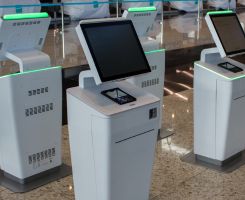Enhancing Military Health Care: The Patient Queuing Notification System
This shapes the way patients access medical services and the efficiency which health care providers deliver them. One innovation quietly transforming the patient experience is the Patient Queuing Notification System. This cutting-edge technology, implemented at most military hospitals and clinics, has improved the quality of care, and enhanced the overall patient journey.
PQNS is a digital system designed to optimize the patient queuing process. The traditional scene of patients languishing in crowded waiting rooms, unsure of when their turn will come, is becoming a thing of the past. Adding PQNS enables military hospitals and clinics to shift to a more patient-centric approach.
PQNS automates the process for patient check-in at military hospitals and clinics. Patients use it to self-check in for appointments and to get prescriptions.
“Patients at military hospitals and clinics usually access PQNS via a kiosk,” said Brian Schafer, deputy program manager of Program Executive Office Medical Systems. “The system allows a patient to scan their Department of Defense identification card and check in to a pharmacy or clinic, then receive further instructions on where to go next to complete their patient visit.”
When beneficiaries check in using PQNS, they are assigned a queue number. This number determines their place in line, ensuring fairness and an optimized order of service delivery. The staff is notified that the patient has arrived and can quickly and accurately place them in their appropriate place in the queue.
According to a AMIA Joint Summits on Translational Science Proceedings study, the average wait time for patients checking in to the emergency department for influenza testing decreased by 27% when using an electronic notification system.
PQNS has been used ad hoc within the Military Health System since 2009 when individual military hospitals and clinics placed it on their local servers. In 2017, the Defense Health Agency purchased an enterprise software license, saving time and money for the military hospitals and clinics.
In 2021, in response to the COVID-19 pandemic, the DHA and the original vendor, developed Q-Anywhere. Q-Anywhere allows patients to use their mobile phones to check in to the pharmacy or appointment, avoiding crowded waiting rooms, explained Schafer. Smartphone use now allows beneficiaries to manage their wait time, knowing exactly how long they have until their turn.
Implementing PQNS does have challenges, including the need for a robust information technology infrastructure. In 2023, the DHA completed a migration of 120 hospital and clinic servers to four regionalized servers, a software and database upgrade, and a bi-directional interface to MHS GENESIS.
PQNS represents a transformative technology for military health care, added Schafer. “It is not just a technological advancement. It’s a symbol of respect and care for those who selflessly serve their country. As it evolves and expands, it stands as a testament to the unwavering commitment to providing the very best in health care to our military service members, families, and retirees.”
Article Source: Enhancing Military Health Care: The Patient Queuing Notification System
